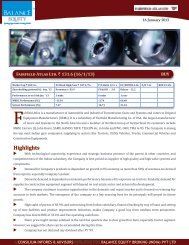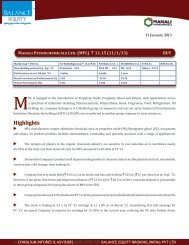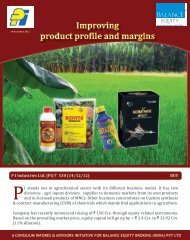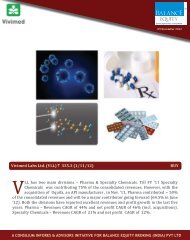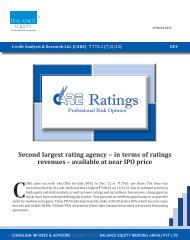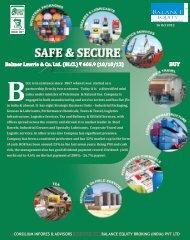Policy framed based on Prevention of Money Laundering Act, 2002 ...
Policy framed based on Prevention of Money Laundering Act, 2002 ...
Policy framed based on Prevention of Money Laundering Act, 2002 ...
Create successful ePaper yourself
Turn your PDF publications into a flip-book with our unique Google optimized e-Paper software.
<str<strong>on</strong>g>Policy</str<strong>on</strong>g> <str<strong>on</strong>g>framed</str<strong>on</strong>g> <str<strong>on</strong>g>based</str<strong>on</strong>g> <strong>on</strong> Preventi<strong>on</strong> <strong>of</strong> M<strong>on</strong>ey <strong>Laundering</strong> <strong>Act</strong>, <strong>2002</strong>, the Rules <str<strong>on</strong>g>framed</str<strong>on</strong>g><br />
there under and Circulars issued by Regulatory Authorities.<br />
A. Principal Officer<br />
As per the requirement <strong>of</strong> Preventi<strong>on</strong> <strong>of</strong> M<strong>on</strong>ey <strong>Laundering</strong> <strong>Act</strong>, <strong>2002</strong>, a Principal Officer will be appointed and<br />
informed to FIU. Principal Officer will be resp<strong>on</strong>sible for reporting any transacti<strong>on</strong>s covered under Preventi<strong>on</strong> <strong>of</strong> M<strong>on</strong>ey<br />
<strong>Laundering</strong> <strong>Act</strong>, <strong>2002</strong>.<br />
B. Customer Due Diligence<br />
1. New customer acceptance procedures adopted include following processes:<br />
An updated list <strong>of</strong> individuals and entities which are subject to various sancti<strong>on</strong> measures such as freezing <strong>of</strong> assets/<br />
accounts, denial <strong>of</strong> financial services etc., as approved by Security Council Committee established pursuant to various<br />
United Nati<strong>on</strong>s’ Security Council Resoluti<strong>on</strong>s (UNSCRs) can be accessed in the United Nati<strong>on</strong>s website at http://www.<br />
un.org/sc/committees/1267/c<strong>on</strong>solist.shtml. Before opening any new account, it will be ensured that the name/s <strong>of</strong><br />
the proposed customer does not appear in the list. Further, c<strong>on</strong>tinuously scan all existing accounts to ensure that no<br />
account is held by or linked to any <strong>of</strong> the entities or individuals included in the list. Full details <strong>of</strong> accounts bearing<br />
resemblance with any <strong>of</strong> the individuals/entities in the list should immediately be intimated to SEBI and FIU-IND<br />
a) Customer identificati<strong>on</strong> and verificati<strong>on</strong> depending <strong>on</strong> nature /status <strong>of</strong> the customer and kind <strong>of</strong> transacti<strong>on</strong>s that<br />
are expected by the customer. Also at the time <strong>of</strong> commencement <strong>of</strong> an account-<str<strong>on</strong>g>based</str<strong>on</strong>g> relati<strong>on</strong>ship, identify its<br />
clients, verify their identity and obtain informati<strong>on</strong> <strong>on</strong> the purpose and intended nature <strong>of</strong> the business relati<strong>on</strong>ship.<br />
b) One certified copy <strong>of</strong> an ‘<strong>of</strong>ficially valid document’ c<strong>on</strong>taining details <strong>of</strong> his identity and address, <strong>on</strong>e recent<br />
photograph and such other documents including in respect <strong>of</strong> the nature <strong>of</strong> business and financial status <strong>of</strong> the<br />
client.<br />
c) False / incorrect identificati<strong>on</strong> <strong>of</strong> documents<br />
c) Client should remain present for registrati<strong>on</strong> pers<strong>on</strong>ally<br />
d) Compliance with guidelines issued by various regulators such as SEBI, FIU, RBI etc.<br />
e) Establishing identity <strong>of</strong> the client, verificati<strong>on</strong> <strong>of</strong> addresses, ph<strong>on</strong>e numbers and other details.<br />
f) Obtaining sufficient informati<strong>on</strong> in order to identify pers<strong>on</strong>s who beneficially own or c<strong>on</strong>trol the trading account.<br />
Whenever it is apparent that the securities acquired or maintained through an account are beneficially owned by<br />
entity other than the client<br />
g) Verificati<strong>on</strong> <strong>of</strong> the genuineness <strong>of</strong> the PAN provided by the client such as comparing with original PAN, checking<br />
details <strong>on</strong> the Income tax website etc.<br />
h) Checking original documents before accepting a copy.<br />
i) Asking for any additi<strong>on</strong>al informati<strong>on</strong> as deemed fit <strong>on</strong> case to case basis to satisfy about the Genuineness and<br />
financial standing <strong>of</strong> the client.
i) Ask the client has any criminal background, whether he has been at any point <strong>of</strong> time been associated in any civil or<br />
criminal proceedings anywhere.<br />
k) Checking whether at any point <strong>of</strong> time he has been banned from trading in the stock market.<br />
And<br />
(b) in all other cases, verify identity while carrying out:<br />
(i) transacti<strong>on</strong> <strong>of</strong> an amount equal to or exceeding rupees fifty thousand, whether c<strong>on</strong>ducted as a single transacti<strong>on</strong> or<br />
several transacti<strong>on</strong>s that appear to be c<strong>on</strong>nected, or<br />
(ii) any internati<strong>on</strong>al m<strong>on</strong>ey transfer operati<strong>on</strong>s.<br />
(1 A) Identify the beneficial owner and take all reas<strong>on</strong>able steps to verify his identity.<br />
(1 B) Ongoing due diligence with respect to the business relati<strong>on</strong>ship with every client and closely examine the<br />
transacti<strong>on</strong>s in order to ensure that the same is c<strong>on</strong>sistent with knowledge <strong>of</strong> the customer, his business and risk<br />
pr<strong>of</strong>ile.<br />
(1 C) Member shall keep any an<strong>on</strong>ymous account or account in fictitious names.<br />
2. For existing clients processes include:<br />
a) Review <strong>of</strong> KYC details <strong>of</strong> all the existing active clients in c<strong>on</strong>text to the PMLA <strong>2002</strong> requirements.<br />
b) Classificati<strong>on</strong> <strong>of</strong> clients into high, medium or low risk categories <str<strong>on</strong>g>based</str<strong>on</strong>g> <strong>on</strong> KYC details, trading activity etc<br />
for closer m<strong>on</strong>itoring <strong>of</strong> high risk categories.<br />
c) Obtaining <strong>of</strong> annual financial statements from all clients, particularly those in high risk categories.<br />
d) In case <strong>of</strong> n<strong>on</strong> individuals client additi<strong>on</strong>al informati<strong>on</strong> about the directors, partners, dominant promoters,<br />
major shareholders is obtained.<br />
C. Risk <str<strong>on</strong>g>based</str<strong>on</strong>g> approach:<br />
Following Risk <str<strong>on</strong>g>based</str<strong>on</strong>g> KYC procedures are adopted for all clients:<br />
1. Large number <strong>of</strong> accounts having a comm<strong>on</strong> account holder<br />
2. Unexplained transfers between multiple accounts with no rati<strong>on</strong>ale<br />
3. Unusual activity compared to past transacti<strong>on</strong>s<br />
4. Doubt over the real beneficiary <strong>of</strong> the account<br />
5. Payout/pay-in <strong>of</strong> funds and securities transferred to /from a third party<br />
6. Off market transacti<strong>on</strong>s especially in illiquid stock and in F & O, at unrealistic prices<br />
7. Large sums being transferred from overseas for making payments<br />
8. Inc<strong>on</strong>sistent with the clients’ financial background<br />
D. Clients <strong>of</strong> special category (CSC)<br />
i. N<strong>on</strong> resident clients,<br />
ii. High net-worth clients,<br />
iii. Trust, Charities, NGOs and organizati<strong>on</strong>s receiving d<strong>on</strong>ati<strong>on</strong>s,<br />
iv. Companies having close family shareholdings or beneficial ownership,
v. Politically exposed pers<strong>on</strong>s (PEP). Politically exposed pers<strong>on</strong>s are individuals who are or have been entrusted<br />
with prominent public functi<strong>on</strong>s in a foreign country, e.g., Heads <strong>of</strong> States or <strong>of</strong> Governments, senior politicians,<br />
senior government/judicial/ military <strong>of</strong>ficers, senior executives <strong>of</strong> state-owned corporati<strong>on</strong>s, important<br />
political party <strong>of</strong>ficials, etc. The additi<strong>on</strong>al norms applicable to PEP as c<strong>on</strong>tained in the subsequent clause 5.5<br />
(Page 19 <strong>of</strong> the Master Circular) shall also be applied to the accounts <strong>of</strong> the family members or close relatives <strong>of</strong><br />
PEPs,<br />
vi. Companies <strong>of</strong>fering foreign exchange <strong>of</strong>ferings,<br />
vii. Clients in high risk countries (where existence / effectiveness <strong>of</strong> m<strong>on</strong>ey laundering c<strong>on</strong>trols is suspect or which<br />
do not or insufficiently apply FATF standards, where there is unusual banking secrecy, Countries active in<br />
narcotics producti<strong>on</strong>, Countries where corrupti<strong>on</strong> (as per Transparency Internati<strong>on</strong>al Corrupti<strong>on</strong> Percepti<strong>on</strong><br />
Index) is highly prevalent, Countries against which government sancti<strong>on</strong>s are applied, Countries reputed to be<br />
any <strong>of</strong> the following – Havens / sp<strong>on</strong>sors <strong>of</strong> internati<strong>on</strong>al terrorism, <strong>of</strong>fshore financial centers, tax havens,<br />
countries where fraud is highly prevalent,<br />
viii. N<strong>on</strong> face to face clients,<br />
ix. Clients with dubious reputati<strong>on</strong> as per public informati<strong>on</strong> available etc.<br />
X. Where the client is a juridical pers<strong>on</strong>, verify that any pers<strong>on</strong> purporting to act <strong>on</strong> behalf <strong>of</strong> such client is so<br />
authorised and verify the identity <strong>of</strong> that pers<strong>on</strong>.<br />
E. M<strong>on</strong>itoring & Reporting <strong>of</strong> Suspicious Transacti<strong>on</strong>s:<br />
“Suspicious transacti<strong>on</strong>” means a transacti<strong>on</strong> whether or not made in cash, which to a pers<strong>on</strong> acting in good faith -<br />
(a) gives rise to a reas<strong>on</strong>able ground <strong>of</strong> suspici<strong>on</strong> that it may involve proceeds <strong>of</strong> an <strong>of</strong>fence specified in the Schedule<br />
to the <strong>Act</strong>, regardless <strong>of</strong> the value involved; or<br />
(b) appears to be made in circumstances <strong>of</strong> unusual or unjustified complexity; or<br />
(c) appears to have no ec<strong>on</strong>omic rati<strong>on</strong>ale or b<strong>on</strong>afide purpose; or<br />
(d) gives rise to a reas<strong>on</strong>able ground <strong>of</strong> suspici<strong>on</strong> that it may involve financing <strong>of</strong> the activities relating to<br />
terrorism;’.<br />
Ongoing m<strong>on</strong>itoring <strong>of</strong> accounts which includes<br />
1. Identificati<strong>on</strong> and detecti<strong>on</strong> <strong>of</strong> apparently abnormal transacti<strong>on</strong>s.<br />
2. Generati<strong>on</strong> <strong>of</strong> necessary reports/alerts <str<strong>on</strong>g>based</str<strong>on</strong>g> <strong>on</strong> clients’ pr<strong>of</strong>ile, nature <strong>of</strong> business, trading pattern <strong>of</strong> clients<br />
for identifying and detecting such transacti<strong>on</strong>s. These reports/alerts are analyzed to establish suspici<strong>on</strong> or<br />
otherwise for the purpose <strong>of</strong> reporting such transacti<strong>on</strong>s. Following parameters are used:<br />
i) Clients whose identity verificati<strong>on</strong> seems difficult or clients appear not to cooperate<br />
ii) Substantial increase in activity without any apparent cause<br />
iii) Large number <strong>of</strong> accounts having comm<strong>on</strong> parameters such as comm<strong>on</strong> partners / directors / promoters /<br />
address / email address / teleph<strong>on</strong>e numbers / introducers or authorized signatories;<br />
iv) Transacti<strong>on</strong>s with no apparent ec<strong>on</strong>omic or business rati<strong>on</strong>ale<br />
v) Sudden activity in dormant accounts;<br />
vi) Source <strong>of</strong> funds are doubtful or inc<strong>on</strong>sistency in payment pattern;<br />
vii) Unusual and large cash deposits made by an individual or business;<br />
viii) Transfer <strong>of</strong> investment proceeds to apparently unrelated third parties;<br />
ix) Multiple transacti<strong>on</strong>s <strong>of</strong> value just below the threshold limit <strong>of</strong> Rs 10 Lacs specified in PMLA so as to avoid<br />
possible reporting;
x)<br />
xi)<br />
xii)<br />
xiii)<br />
xiv)<br />
xv)<br />
xvi)<br />
xvii)<br />
Clients transferring large sums <strong>of</strong> m<strong>on</strong>ey to or from overseas locati<strong>on</strong>s with instructi<strong>on</strong>s for payment in cash;<br />
Purchases made <strong>on</strong> own account transferred to a third party through <strong>of</strong>f market transacti<strong>on</strong>s through DP<br />
Accounts;<br />
Suspicious <strong>of</strong>f market transacti<strong>on</strong>s;<br />
Large deals at prices away from the market.<br />
Accounts used as ‘pass through’. Where no transfer <strong>of</strong> ownership <strong>of</strong> securities or trading is occurring in the<br />
account and the<br />
account is being used <strong>on</strong>ly for funds transfers/layering purposes.<br />
All transacti<strong>on</strong>s involving receipts by n<strong>on</strong>-pr<strong>of</strong>it organisati<strong>on</strong>s <strong>of</strong> value more than rupees ten lakh, or its<br />
equivalent in foreign currency;<br />
clients <strong>of</strong> high risk countries, including countries where existence and effectiveness <strong>of</strong> m<strong>on</strong>ey laundering<br />
c<strong>on</strong>trols is suspect or which do not or insufficiently apply FATF standards, as ‘Clients <strong>of</strong> Special Category’.Such<br />
clients should also be subject to appropriate counter measures. These measures may include a further enhanced<br />
scrutiny <strong>of</strong> transacti<strong>on</strong>s, enhanced relevant reporting mechanisms or systematic reporting <strong>of</strong> financial<br />
transacti<strong>on</strong>s, and applying enhanced due diligence while expanding business relati<strong>on</strong>ships with the identified<br />
country or pers<strong>on</strong>s in that country etc.<br />
Irrespective <strong>of</strong> the amount <strong>of</strong> transacti<strong>on</strong> and/or the threshold limit envisaged for predicate <strong>of</strong>fences specified<br />
in part B <strong>of</strong> Schedule <strong>of</strong> PMLA, <strong>2002</strong>, file STR if we have reas<strong>on</strong>able grounds to believe that the transacti<strong>on</strong>s<br />
involve proceeds <strong>of</strong> crime.”<br />
F. Reporting <strong>of</strong> Suspicious Transacti<strong>on</strong>s:<br />
1. All suspicious transacti<strong>on</strong>s will be reported to FIU. Member and its employees shall keep the fact <strong>of</strong> furnishing<br />
informati<strong>on</strong> in respect <strong>of</strong> transacti<strong>on</strong>s referred to in clause (D) <strong>of</strong> sub-rule (1) <strong>of</strong> rule 3 strictly c<strong>on</strong>fidential.<br />
2. The background including all documents/<strong>of</strong>fice records /memorandums/clarificati<strong>on</strong>s sought pertaining to<br />
such transacti<strong>on</strong>s and purpose there<strong>of</strong> shall also be examined carefully and findings shall be recorded in writing.<br />
Further such findings, records and related documents should be made available to auditors and also to SEBI /<br />
Stock Exchanges/FIU-IND/Other relevant Authorities, during audit, inspecti<strong>on</strong> or as and when required. These<br />
records are required to be preserved for ten years as is required under PMLA <strong>2002</strong>.<br />
3. The Principal Officer and related staff members shall have timely access to customer identificati<strong>on</strong> data and other<br />
CDD informati<strong>on</strong>, transacti<strong>on</strong> records and other relevant informati<strong>on</strong>. The Principal Officer shall have access to<br />
and be able to report to senior management above his/her next reporting level or the Board <strong>of</strong> Directors.<br />
G. On going training to Employees:<br />
1) Importance <strong>of</strong> PMLA <strong>Act</strong> & its requirement to employees through training.<br />
2) Ensuring that all the operating and management staff fully understands their resp<strong>on</strong>sibilities under PMLA for<br />
strict adherence to customer due diligence requirements from establishment <strong>of</strong> new accounts to transacti<strong>on</strong><br />
m<strong>on</strong>itoring and reporting suspicious transacti<strong>on</strong>s to the FIU.<br />
3) Organising suitable training programmes wherever required for new staff, fr<strong>on</strong>t-line staff, supervisory staff, etc.<br />
H. Audit and Testing <strong>of</strong> Anti M<strong>on</strong>ey <strong>Laundering</strong> Program.<br />
The Anti M<strong>on</strong>ey <strong>Laundering</strong> program is subject to periodic audit, specifically with regard to testing its adequacy to<br />
meet the compliance requirements. The audit/testing is c<strong>on</strong>ducted by Trading Member’s own pers<strong>on</strong>nel not involved<br />
in framing or implementing the AML program. The report <strong>of</strong> such an audit/testing is placed for making suitable<br />
modificati<strong>on</strong>s/improvements in the AML program.



